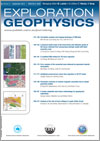
Exploration Geophysics
Volume 43 Number 3 2012
EG11034Correlation analysis and imaging technique of TEM data
Mathematically, transient electromagnetic method (TEM) data can be converted into virtual waves. It is possible to process TEM data using the synthesised imaging method, which originates from radar data processing. The technology can improve TEM resolution. Both synthetic and survey data show that synthetic aperture imaging is an effective way of developing TEM imaging technology.
EG10033A physical model study of the travel times and reflection points of SH-waves reflected from transversely isotropic media with tilted symmetry axes
The reflection moveouts of SH-waves reflected from a transversely isotropic layer with tilted symmetry axis computed by the modified hyperbolic equation and Fermat’s principle fit well to the physical data. Their reflection points will shift away from the common midpoint when the symmetry axes are not vertical and horizontal.
A modified EOM method is developed for PS-wave migration based on the equivalent offset migration (EOM) for P-waves and an equivalent PS-wave velocity. A 2D3C seismic case study shows that the method can give better imaging quality than the conventional CCP method by reducing discretisation errors and suppressing noise.
EG11039Error analysis of the converted wave deduced by equivalent velocity assumption
Under the assumption of the equivalent velocity, the converted wave can be easily migrated in the time domain based on the equivalent offset method (EOM). In this paper, the analysis of errors caused by the introduction of the equivalent velocity for the PS-wave and the conditions for applying common scatterpoint (CSP) gathers are presented.
EG11037Amplitude-preserved pre-stack time migration in 3D VTI media
We present a method of amplitude-preserved pre-stack time migration in 3D VTI media. An imaging weight and the estimation of stacking anisotropic parameters are introduced to produce amplitude-preserved image gathers. The time-dependent migration aperture corresponding to the dip of subsurface structure is used to balance imaging quality and imaging noises.
EG11026Parametric inversion of residual magnetic anomalies due to simple geometric bodies
We present a method to determine the model parameters of a buried structure from a residual magnetic anomaly profile using a new formula representing the magnetic anomaly expressions produced by most geological structures. The method has the capability of avoiding highly noisy data points to enhance the interpretation results.
EG11036A simple adaptable data fusion methodology for geophysical exploration
We present a simple grid/image-based method of data fusion for use with georectified geophysical data. In this study, we fuse aeromagnetic, radiometric and VLF data acquired over the Hemlo gold deposit of Northern Ontario, Canada. The results clearly show a strong and unique anomaly within the area of surficial mineralization.
EG10020Analysis of the risk of karst collapse in Lapão, Bahia, Brazil
Dissolution of limestone in a karst area resulted in ground shakes and enhancement of fractures. Gravity and electro-resistivity profiles mapped concealed caves, determined groundwater level, and defined five risk areas by correlating gravity lows with caves and conductive zones with brine water, providing information for future hydrological and geotechnical work.

